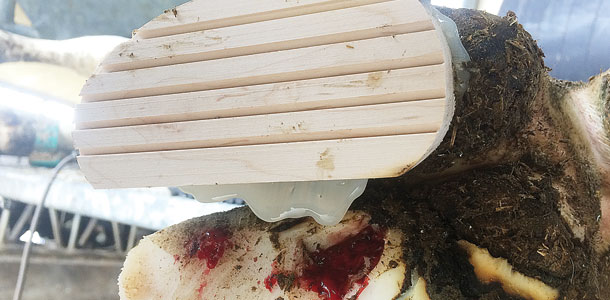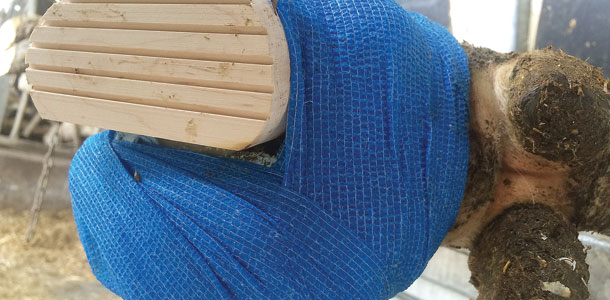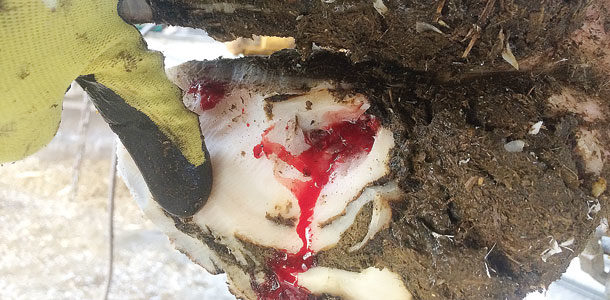Over the years, I have come to understand that nutrition and foot health go hand-in-hand. I learned that rations are directly related to laminitis, and laminitis is often the reason we have sole ulcers, which are a major lameness concern.
I have also learned that the largest cause of lameness is denial. If you don’t admit you have a problem, you cannot fix it, and you must be open to ideas to make improvements.
I come from a hoof-trimming family, where my father, Tom Kent, ran a trimming school. After graduating from high school in 2002, I made my way into the hoof-trimming business myself, attending the school and completing an extensive apprenticeship. One of the basic principles I learned along the way was to keep the job simple. Understand scoring, understand how the feet work, and pay attention to the details.
As I started to really pay attention to herds with too many lame cows, I noticed a few things. There was a tendency that farms with greater incidence of sole ulcers were also feeding a very high corn level in their rations.
I noticed that the cows were often thin and even ketotic. I also noticed the manure was almost liquid. As I evaluated the variables in these herds, I started asking myself why some of my farms were struggling with lameness.
On one of these farms, I noticed a change. As I made my monthly visits, the cows were no longer looking so thin, and their manure was not so loose. The cows were now big, strong, healthy and shiny. Better yet, the ulcers had seemingly disappeared, and the trimming bill was down. It seemed like a new farm.

So what had changed in just a matter of a few weeks? The barn, stalls, equipment, bedding, breeding and trimming were all the same. To my surprise, it was a new nutritionist. Milk production was up, and the trimming schedule focused from fixing problems to maintenance.
So what was the biggest change and why did it help so much? I am not a nutritionist, as that is not my field, but to understand and better serve my customers I set out to find some answers. I sat down with a veterinarian and a nutritionist whom I know and trust to discuss this topic, and this is what we concluded: Your dry cow ration is where it starts.
If you get the ration right for dry cows, everything else falls into place. Among herds that had laminitis problems, there was a tendency to feed too much energy. The problem with too much energy is: The cow cannot digest it properly. A low rumen balance occurs, and the bacteria that naturally makes the cows’ B vitamins cannot survive.
Too much grain makes the diet too starchy, and too much starch triggers laminitis. A cow will only eat to fulfill her energy needs. Milk cow rations need to be kept simple. Sometimes too many products are mixed in. In some cases, removing products instead of adding them can make the difference.
As humans, we are not much different. A proper diet influences energy levels and performance. When I was younger, my diet was bad. I had no muscle or weight of any kind. I decided to change that and hired a trainer and went to work. I added 48 pounds over seven months and went down 1 percent in body fat.
Because I changed what was going into my body, the rest followed. My posture became better, my sports injuries went down, and I was hungry … a lot. I didn’t have high levels of sugar and my protein was way up, so naturally, I ate more. When I ate more, I felt, looked and performed better.

Cows eat that way too. They will pick corn out of a ration. If your dry cow ration is high in fiber and then goes to a lower fiber and carbohydrate ration, a cow will consume more feed during her dry time. Then, when she freshens and higher carbohydrates are re-introduced, she will be fit, healthy and ready to go.
I have observed among fresh cows entering my chute that sole ulcers and ketosis often go hand-in-hand. Affected cows tend to be crampy and poor milk producers, which makes the farmer unhappy. If the nutritionist increases the grain and corn silage and lowers the dry matter, that can make lameness problems worse.
Just like days gone by, when cows were “turned out” in the spring, we would see a higher incidence of ulcers because the sugars in the spring pasture were too high. The same thing is happening now. You can’t force energy into cows. We know that when cows are lame, they lie down more – but when they get up to eat, they slug feed.
So let’s look at rations when we evaluate lameness. From my experience, getting the hoof trimmer and the nutritionist together can offer a new perspective. In fact, on one of my customers’ farms, I spent an entire morning talking with the nutritionist, which resulted in making some changes to the ration.
I recommended a change in nutrition to another farm, and for the first time in 12 years of trimming, there was not one sole ulcer and milk production was up. A few simple changes can make a huge impact on your herd’s lameness and your bottom line. PD
For any questions visit the Southwestern Hoof Trimming website.
PHOTO 1: When too much grain or corn silage is in the ration, I tend to see more sole ulcers. The ulcers are a symptom of laminitis, which you can see in this case, where the sole is separating from the outside hoof wall and the claw is swollen.
PHOTO 2: To relieve pain and pressure, I treat these with a block.
PHOTO 3: I medicate the wound with tetracycline and wrap the foot to protect it and hold the medication in place for a couple of days. Photos courtesy of Ryan Kent.
-
Ryan Kent
- Owner/Hoof Trimmer
- Southwestern Hoof Trimming Inc.
- Email Ryan Kent






